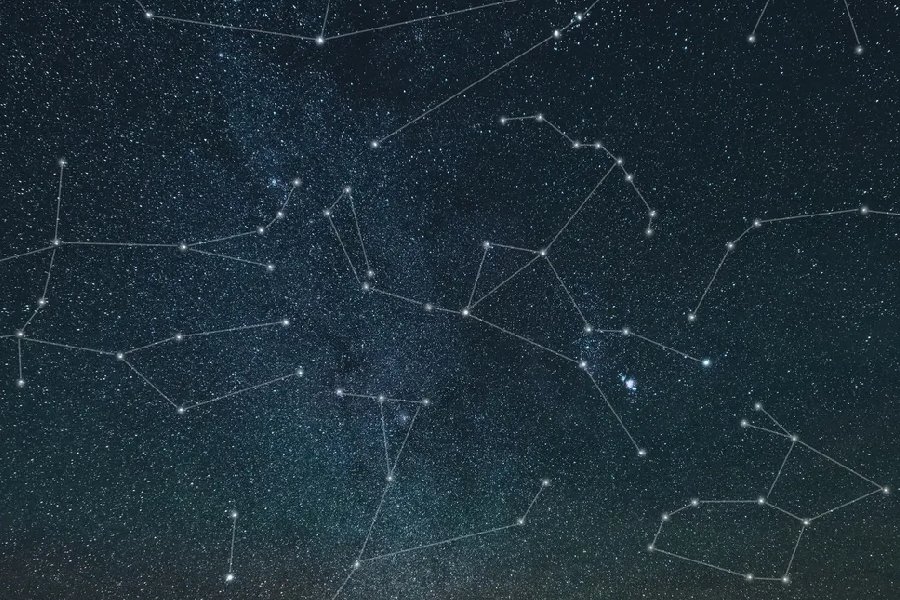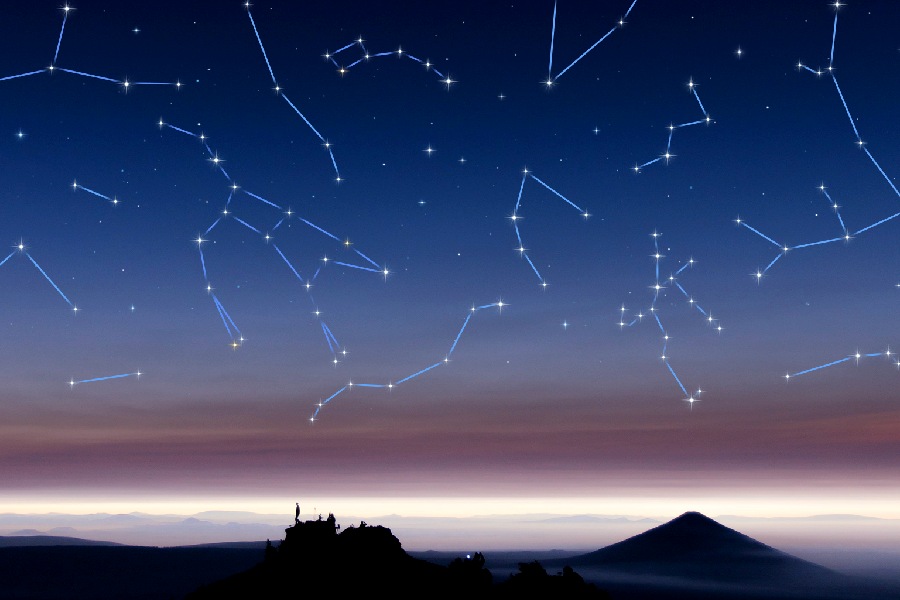Since the dawn of humanity, our ancestors gazed up at the heavens and noticed patterns in the arrangements of stars. They connected these dots to form shapes and figures that helped them track seasons for agriculture, navigation, mythology and more. These starry configurations are called constellations. But what are constellations?
As we survey how cultures named and outlined mythological tales or creatures in the stars, we’ll also cover why constellations appear to move and change throughout the year.
We will also discover the history of constellations and how they aided ancient navigation and still assist star-hopping astronomers. Let’s begin!

What Are Constellations?
Constellations are recognizable star patterns forming shapes in the night sky. They aid navigation and carry cultural significance, representing imaginative arrangements of stars connected by various civilizations.
Why are constellations important? These patterns simplify star identification and have practical uses, such as in navigation and astronomy. Constellations serve as a way to organize and identify stars, making it easier for observers to navigate the vastness of the night sky.
While they are apparent visual groupings from Earth, the stars in a constellation may be at vastly different distances from one another in space. They often carry rich cultural narratives, reflecting various civilizations’ stories, myths, and beliefs.
So, constellations persist as captivating subjects, drawing interest not just for their beauty but also for their historical, cultural, and practical significance. They play crucial roles in activities like navigation and astronomy.
Origin of Constellation Names
Who named constellations? The names and stories behind constellations originate largely from Greek and Roman mythology. Heroes like Orion, creatures like Ursa Major and Lacerta, and objects like Triangulum reflect tales told about the exploits, escapades and dramas of the gods.
Their legends left an imprint upon the sky that still shapes how we perceive the stars at night. Many of the 48 classical Greek constellations outlined by Ptolemy connected stars to characters and beings from ancient myths.
The Romans appended more constellations later. Although the stars forming their shapes are typically unrelated, projecting these stories onto the heavens helped cultures remember the star patterns.
So, whether it was the mighty hunter Orion pursued by a scorpion, the vain queen Cassiopeia relegated to the skies, or the hero Perseus saving Andromeda, these mythological figures gained celestial immortality through the constellations bearing their names.
Well-Known Constellations for Stargazing
The zodiac constellations rank among the most familiar for stargazing. Their sun-based names, like Leo, Libra and Capricorn, connect to astrology, and their vivid star outlines make them favorites for amateur astronomy.
Orion, Ursa Major, Cassiopeia and Cepheus are other northern constellations illuminating the sky with iconic patterns. Orion the Hunter appears in winter evenings, recognizable by its hourglass shape and three perfectly aligned Belt stars.
Following its direction leads south to eye-catching Sirius of Canis Major. Ursa Major’s Big Dipper asterism stands out year-round, pointing to Polaris the North Star. Cassiopeia‘s zigzag “W” shape circles Polaris opposite Ursa Major. As bright northern touchstones, these constellations aid navigation and serve as seasonal mileposts.
Meanwhile, in the southern hemisphere, the Southern Cross, Centaurus and Scorpius act as signpost constellations for scanning the galactic core’s star clouds. Their decorative shapes guide viewers through the central barrens near the Milky Way.

Ancient times
Constellations held great importance for ancient civilizations across Mesopotamia, Egypt, Greece and the Americas in mapping the passage of time through the heavens. Different cultures visualized mythic characters and symbols by connecting stars into patterns.
The ancient Egyptians used the first known star clocks based on observing certain constellations appear over the eastern horizon just before dawn, at predictable times throughout the year. These annual returns tracked the flooding of the Nile and cued the planting season around the heliacal rising of Sirius in Canis Major.
Similarly, agriculture in ancient China relied on the orientation of Orion along with other seasonal constellations. Inca astronomer-priests encoded calendrics into constellations like the Southern Cross and Lyra to regulate seasonal observances. The passing of these constellations dictated rituals from moon ceremonies to the winter solstice Inti Raymi festival of sun worship.
Across early cultures worldwide, constellations reflected their myths while regulating their civilizations through astronomical observations for food production, weather prediction and spiritual practice. Their very cultures relied on the dependability of the constellations wheeling overhead.
Modern times
The study of constellations in astronomy has undergone a profound transition, evolving from ancient mythological interpretations to a more scientific and systematic understanding. Traditionally, constellations were associated with mythological stories, cultural narratives, and symbolic representations. However, as astronomy advanced, the focus shifted towards a more empirical approach.
In the modern era, constellations are defined as specific patterns of stars in the celestial sphere, serving as convenient markers for astronomers to locate celestial objects. The International Astronomical Union (IAU) officially delineated 88 constellations with well-defined boundaries in the early 20th century. It provided a standardized framework for astronomical observations.
This transition marks a shift from subjective, culturally diverse interpretations of the past to a globally accepted and scientifically rigorous classification system. It enables more precise communication and collaboration in the study of the cosmos. Today, constellations play a crucial role in navigating the night sky and remain integral to the foundation of observational astronomy.
Showpiece Stars: Bright and Double Stars by Constellation
The 20 brightest stars shine across 13 different constellations. Sirius dazzles as the sky’s most brilliant star in Canis Major. Arcturus, Vega, Capella and Rigel rank next, their names still echoing ancient origins. Contrasting colorful doubles like Albireo in Cygnus add flourish, making specific constellations destination targets.
The top doubles Almach in Andromeda and Mizar-Alcor in Ursa Major tower over charming compact pairs like Iota Cancri. Tracking down favored singles or pretty duos becomes a “constellation conquest” for amateurs armed with apps and sky maps to hop between constellation gems visible each month.
Modern Official Constellations Recognized by Astronomers
As mentioned, the International Astronomical Union (IAU) officially recognizes 88 modern constellations with strictly defined borders for research purposes. Additional Chinese and historical European constellations persist in classical star atlases but are no longer utilized by astronomers.
The IAU constellations create a standard coordinate system that maps the celestial sphere uniformly. This enables precise tracking of stars and deep sky objects across epochs.
While enhancing scientific study, the official constellations still carry legacy names from Greek legends. These names kindle our imagination, weaving stories of mythical heroes, creatures, and tropes projected symbolically onto the starry canvas overhead.
Conclusion
As we conclude our cosmic journey through the realms of constellations, we hope you have marveled at the richness of these celestial narratives. From ancient mythologies to modern astronomy, constellations have bridged cultures and connected us to the cosmos.
This exploration has unveiled the captivating stories etched in the night sky, guiding both ancient navigators and contemporary stargazers alike. As the stars weaved their tails overhead, we illuminated the answer to the question that sparked our celestial adventure: What are constellations?
In decoding their secrets, we hope this article has enriched your cosmic curiosity and inspired a deeper appreciation for the wonders above. Happy stargazing!
